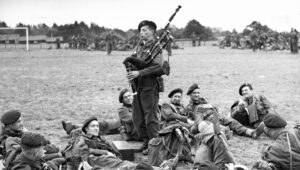Reprinted through the courtesy of Dan Sheppard, Pipe Major
If by chance you know of someone who loves the bagpipe and wants to purchase a set, save them money and frustration by forwarding this article to them.
Several years back, I got a call from a young relative of mine, a teenager at the time, who had found a “bargain” set of pretty bagpipes on eBay. He and his Dad hurriedly bought them before the end of the auction. After they arrived he called me all excited and enthused about learning to play. My worst fears were realized when I discovered, as I had suspected, that he did not find a bargain set of bagpipes at all, he got exactly what he paid for…CRAP.
Rule #1: Never, ever, I repeat, never, ever buy a set of pipes on a whim. You would be surprised how many people start by basically telling themselves, “Wow, I want to learn the pipes so I’d better buy a set and start learning”. I cannot express strongly enough what a mistake this is. A purchase at this early stage will almost inevitably end with a bad or shoddy investment and few can then recoup their loss.
Rule #2: Do not buy your pipes on eBay or the like unless you know what you’re doing. Probably if you’re new to piping and reading this, you don’t. Unlike most other instruments, you don’t learn the pipes on the pipes themselves anyway. Beginners learn the pipes on what is called a practice channel. Forget buying pipes until you are competent on the practice channel.
Rule #3: The practice chanter is relatively inexpensive and will be a valuable tool to you, not only as a beginner but throughout your piping career. For my students and band members, I recommend one style chanter and reeds. This maintains uniformity for the group and subsequently tuning is quicker, leaving more time for actual practicing. If you plan to join a pipe band in your area, I would suggest you buy a channel based on the recommendation of their Pipe Major.
Rule #4: Honestly evaluate your ability and desire to practice. Don’t even waste your money on a practice chanter if you can’t commit time to practice. This just isn’t the type of instrument you can play once a week and get anywhere. If you’re already stretched thin, this might not be the right time in your life to make this commitment. If you get bored or frustrated easily…proceed cautiously. The bagpipes have been said to be one of the hardest instruments to learn. By starting off learning with a practice chanter, you’ll get a feel for the time and effort that is needed and if you find you don’t like it or the timing in your life is wrong, your investment has been minimal.
Rule #5: Take lessons if you can. This is the best way to make progress. Your instructor will also be able to tell you when the time is right for you to move up to the actual pipes. Don’t be discouraged if it takes a while. Going from the practice chanter to the pipes may take anywhere from 3 months to a year. Hopefully, by working through an instructor, you’ll have an opportunity to try out a variety of pipes before you buy.
Rule #6: Network. On average, 1 out of 10 pipe students stick with it, but, the ones who do love it are usually happy to give good, sound advice, share tunes, etc. These pipers can be an invaluable resource to you. Many pipers can be found online. It’s best if they are in your area and you can visit with them. Everyone has their own opinions about pipes, music, just about anything, so talk to as many pipers as you can.
Rule #7: Buy Quality. There are many brands of pipes out there and some are better than others. Buy the best you can afford. Educate yourself on brands then weigh the cost against what you can spend, and choose the best set of pipes for you. If you decide to buy a used set of pipes, always find out the manufacturer. If the seller does not know…don’t buy ‘em. If they describe the “wood” as being, anything but African Black Wood then look elsewhere. There are some pipes made of “Polypenco”, (instrument-grade plastic), which is used for woodwind instruments today. These are a good idea for a beginner who may reach that point of buying a set of pipes but isn’t that dedicated. In most all cases they are less expensive than the African Blackwood sets. For a good set of bagpipes, even those that are used, expect to spend at least $500-$1,000.
My experiences and every encounter I have had with other pipers on this subject have led me to believe that you should never, I repeat, never buy a set of bagpipes made in Pakistan unless you just want something to hang on a wall. Pipes made in Pakistan are vastly substandard in quality compared to reputable pipes manufactured in Scotland, England, Ireland, Canada, and the US. Many pipes from Pakistan aren’t even playable as was the case with my teenage relative.
When I opened the box and saw the Pakistan pipes he so proudly bought through eBay, the leather bag was rock-hard, completely non-pliable and the wood had no weight or density whatsoever. I set them up, seasoned the bag, and tuned them as best I could. They made a noise, but that’s about as kind of a description as I can make. My gut reaction was to tell him he needed to start a fire and put those pipes out of their misery. Bottom line: he tried a few times to make music from the Pakistan pipes and simply gave up. He had lost his money, but what is more important is that he had lost his enthusiasm to learn the bagpipes without even giving himself a proper chance at success.





